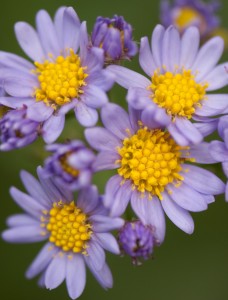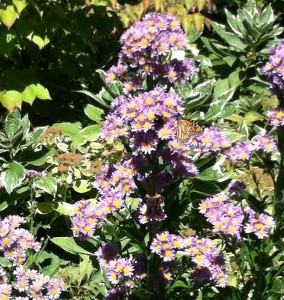Butterfly Bonanza
Posted in Gardening Tips on October 16 2012, by Sonia Uyterhoeven
Sonia Uyterhoeven is the NYBG‘s Gardener for Public Education, often hosting live gardening demonstrations for visitors on Saturdays and Sundays.
 The other week, I was with the Students of Professional Horticulture, taking them on a walk around the Home Gardening Center while discussing wildlife gardening. Technically, any time of the year presents the opportunity to lecture about attracting wildlife into the garden, but fall is a spectacular occasion.
The other week, I was with the Students of Professional Horticulture, taking them on a walk around the Home Gardening Center while discussing wildlife gardening. Technically, any time of the year presents the opportunity to lecture about attracting wildlife into the garden, but fall is a spectacular occasion.
We passed by one of my favorite asters, Aster tartaricus ‘Jindai’, that was smothered with bees and butterflies–monarchs and red admirals on this occasion. ‘Jindai’ is a compact tartarian aster that reaches three to four feet in height (the species can grow up to six feet tall). It was discovered at the Jindai Botanical Garden in Tokyo, Japan.
This sturdy variety has stolen my heart since it doesn’t require any staking. The large foliage of the aster is full at the base of the plant and then tapers nicely as it extends up the stem. In September and October a profusion of flowers adorns these tall stems, a lovely combination of medium purple ray flowers with bright, buttery yellow disc flowers. The complementary colors play off of each other exquisitely.
Butterflies have good vision and like brightly colored flowers, especially those that form a cluster or provide some kind of landing pad for them to rest on. Aster ‘Jindai’ flowers are flat-topped clusters technically called corymbs, so they offer ample space for butterflies to alight as they feed. Late-blooming flowers such as this aster are wonderful sources of nectar for migrating butterflies to feed on, especially beloved by monarchs before they begin their long migration down to the fir forests in the mountains of Mexico.
 If you can’t find this particular aster, another pair of good cultivars with a very different habit–lower and more sprawling–is the long-flowering Aster x frikartii ‘Monch’ that we have growing along our Seasonal Walk, and Aster (Cordifolius Hybrid) ‘Little Carlow’. The blooms are similar in color to ‘Jindai’–a variation of vibrant lavender-purple with bright yellow centers. These two cultivars work well for the middle or the front of a border, while ‘Jindai’ works best further back in the border when paired with a tall chrysanthemum such as Chrysanthemum x rubellum ‘Sheffield Pink’.
If you can’t find this particular aster, another pair of good cultivars with a very different habit–lower and more sprawling–is the long-flowering Aster x frikartii ‘Monch’ that we have growing along our Seasonal Walk, and Aster (Cordifolius Hybrid) ‘Little Carlow’. The blooms are similar in color to ‘Jindai’–a variation of vibrant lavender-purple with bright yellow centers. These two cultivars work well for the middle or the front of a border, while ‘Jindai’ works best further back in the border when paired with a tall chrysanthemum such as Chrysanthemum x rubellum ‘Sheffield Pink’.
You do not have to fear caterpillars destroying your garden earlier in the season before they morph into beautiful butterflies. They generally prefer weedy plants or large specimens to feed on such as violas (Viola), clover (Trifolium), nettles (Urtica), black cherry (Prunus serotina), dogwoods (Cornus), willows (Salix) and blueberries (Vaccinium). Good butterfly plants for your garden are hyssop (Agastache), false indigo (Baptisia), lilac (Syringa), milkweed (Asclepias), coneflower (Echinacea), beebalm (Monarda) and sweet pepperbush (Clethra) to name a few.
Autumn is a great time of the year to come to The New York Botanical Garden and admire bees, birds, butterflies, praying mantis and, if you are lucky, a hummingbird.


Saturday, Oct 20 11.15am – Spotted, what seemed like an unusual numbers of butterflies in an evergreen fir tree. With binoculars, there was one rather large orange colored moth, sitting on some fir “leaves”. Around the upper third of the tree trunk were monarchs, I think? I would love to understand why the butterflies were so far up? Thank you.